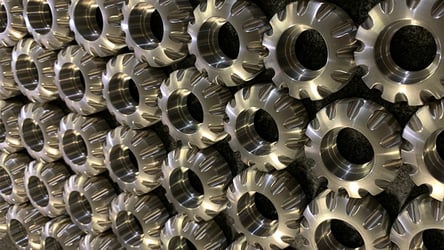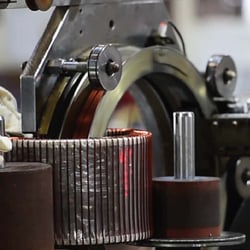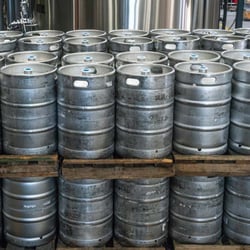Finite Capacity Scheduling is a method of production planning and scheduling that manufacturing companies use to maximize asset usage based on materials and orders on hand. Typically the most expensive, and thus the most valuable resource in your facility is your equipment. Each piece of equipment has a limited or finite capacity, and the goal is always to maximize usage of these resources.
Why all the focus on maximizing resources through production planning and scheduling? World-class manufacturers that master, optimize, and balance the production schedule have a direct impact on on-time delivery, inventories, and profitability. Despite everyone's hard work and no matter how great the ERP or MRP system is, everyday problems can disrupt production, drive up costs, and cause supply chain challenges like:
- New rush orders
- Raw material shortages
- Unplanned machine downtime
- Order cancellations
- Shop floor workers unexpectedly out or reassigned to other areas
Understanding your company's specific objectives, challenges, and environment is the just the first step to production planning and scheduling success. Which combination of these scenarios and approaches does your company resemble?
Finite Capacity Scheduling and Resources
Equipment
Also referred to as assets, equipment are typically the primary focus of any Finite Capacity Scheduling system.
If the top priority is to maximize the run time and thus production of equipment, typically the next priority is Production Order deadlines. Use of Finite Capacity Software tools allows Planners to view the best allocation of order to maximize both equipment utilization and on time deliveries.
Personnel
In most industries, maximizing personnel time is the third priority after equipment utilization and on time delivery. For manufacturing processes that rely mostly on equipment to perform manufacturing tasks, maximizing equipment utilization often has a direct correlation to maximizing personnel utilization.
However, in some industries such as complex assembly or craft food and beverage, labor is a higher cost item than equipment. In this case, Personnel is used as the primary asset to schedule around, with Production Order deadlines the second priority, and equipment and materials third and fourth.
Materials
Materials always play a huge role in Finite Capacity Scheduling. Raw Materials are required to complete the scheduled batch or operation. Finished Goods materials are the goal of the production facility, and accurate forecasting of finished goods are critical for high on time delivery and ultimately high profitability.
Intermediate materials can often receive less attention than raw materials or finished goods, but are just as critical to an efficiently run facility. Intermediate materials are materials that are created as a result of a manufacturing process, and will be used for the next downstream manufacturing process. In many cases, there isn’t a 1 to 1 ratio between the intermediate materials produced by the first manufacturing process and the materials consumed by the preceding manufacturing process. This results in the need to manage and track intermediate material quantities and use these numbers as a factor in scheduling.
Finite Capacity Scheduling software allows the Planner to see in real time the actual intermediate material levels, as well as simulate and forecast intermediate materials levels as a result of the scheduled batches or operations scheduled.
Finite Capacity Scheduling and Production Approaches
Engineer to Order
Manufacturing facilities that Engineer to Order (ETO) have a unique set of challenges when scheduling. Because every order is different, it is difficult to develop rules that can be used to make scheduling predictable.
For this reason, ETO typically sees high ROI from computerized Finite Capacity Scheduling approaches. By using a computerized system, different routes and start times can quickly be simulated, allowing a Planner to visualize the optimum schedule.
This simple route works well for the manufacturing of discrete parts, but often routes are more complex and include dependencies as you will see in the following sections.
Make to Order
Make to Order (MTO) facilities have a luxury that ETO facilities often do not; with the exception of new product releases they are making a product that has been made before. This allows MTO facilities to compile a list of rules that can be used to automatically schedule Production Orders. However, MTO facilities are more complex today than in years past. Even companies that rely on profits from a small number of flagship brands are seeing a rising demand to offer more packaging sizes, more flavors, colors, seasonal offerings, etc. Offering consumers more choices results in more SKUs, which results in a much more difficult scheduling task.
Even the same product packaged in different container sizes or different labels can be difficult to schedule with the use of a computerized Finite Capacity Scheduling system. Factor in change over time, clean in place, and preventative maintenance activities and many MTO facilities can be a more complex scheduling task than their ETO counterparts.
Make to Stock
If ETO and MTO facilities are complex, Make to Stock (MTS) must be a simpler scheduling task, right? Like MTO, with the exception of new product releases, the product being produced has been made before. Unlike MTO, the product being produced is going into storage, meaning there is often a buffer allowing deadlines to be more flexible. So, no need for Finite Capacity Scheduling tools for MTS facilities, right?
If the material quality is predictable, and the product mix is low, many MTS facilities can get away with using traditional scheduling methods. However, even in these cases there is probably some spare capacity that can be gained through computerized Finite Capacity Scheduling, or inventory that can be further leaned out. R.O.Why can work with you to do a quick ROI calculation to see if an investment is worthwhile.
However, like the MTO facility discussion, MTS facilities are seeing an increase in the number of SKUs, raw material prices continue to rise, skilled labor is more and more scarce, and some industries have to deal with seasonal materials or raw material spoilage. Factor in these variables and Finite Capacity Scheduling software can make a large impact on the bottom line of a MTS facility.
Finite Capacity Scheduling and Production Processes
Discrete
Automotive
Discrete Manufacturing is complex topic. Automotive manufacturing is considered Discrete, but with quick cycle times, both MTO and MTS production models, and highly automated facilities with high volume. Specialized control systems have been developed in Automotive to automate scheduling systems and coordinate with line side suppliers in a high speed environment. Automotive scheduling is typically too specialized for a flexible Finite Capacity Scheduling tool.
Automotive tier suppliers are often a great fit for Finite Capacity Scheduling software. Demands from the automotive companies can change quickly, and late delivery isn’t tolerated. By optimizing scheduling typically an automotive supplier can increase efficiency and lean out inventory levels while still meeting on time delivery demands.
Job Shops
Jobs Shops typically yield a great ROI as a result of Finite Capacity Scheduling software tools. With a high order mix, mostly ETO or MTO type production, and quick cycle times, scheduling and planning is a difficult task. Quick optimization of these schedules results in large capacity improvements from increase equipment utilization, lower costs and raising profits. In addition, a clear schedule allows for shorter lead times for rush orders, giving Job Shops a huge competitive advantage over their competitors.
Manual Assembly
Companies specializing in manual assembly offer unique scheduling challenges. The main scheduling constraint is labor, not equipment, thus the focus of optimization is labor. Some manual assembly of large equipment involves Bill of Materials with thousands of parts, hundreds of operations, and long cycle times. This complex environment is well suited for Finite Capacity Scheduling.
Other manual assembly operations are high mix, high volume with short cycle times, smaller Bill of Materials and less operations. This requires a different type of scheduling expertise that still benefits greatly from Finite Capacity Scheduling software tools. Every facility is different, so R.O.Why can work with you to do a quick ROI calculation and see if the benefit justifies the cost.
Batch
Batch manufacturing processes introduce the element of vessel sizes into scheduling and planning. In a perfect world, every vessel has the same capacity and a batch can easily transfer from one manufacturing process to the next. Unfortunately, very few facilities have this luxury, and vessel size must be accounted for when optimizing resource utilization. Add in a large number of SKUs, changing material quality, and both MTO and MTS manufacturing models, and batch manufacturing can be very complex to schedule.
Then you have storage vessels and packaging lines to contend with. Some batch processes have long lead times, while a packaging process can consume that batch quickly. How do you ensure you are running the correct batch for the future demand, and you’ll have the correct packaging materials on hand? Finite Capacity Scheduling software helps you manage this, and simulate the results of your schedule.
Brewing
Look at the brewing industry. Often is it difficult to forecast consumption rates of products, especially when seasonal beers are added in to the plan. Without accurate tracking of finished good holding tank inventory levels and raw materials, a Brew Master spends a lot of time auditing inventory before even beginning the scheduling process. Finite Capacity Scheduling software provides everyone in the Brewery with accurate inventory levels, material levels, and real time status of each brew, allowing the Planner to optimize usage of fermentation tanks, holding tanks, packaging equipment, and staff.
Continuous
By definition, a continuous process always runs making the same product. So, no scheduling complexities there, right?
Of course, the continuous process is often followed by discrete processes to assemble or package the result of the continuous process, adding complexity to the scheduling. By optimizing the packaging operations companies ensure the continuous process keeps running, and keeps making the company money. Finite Capacity Scheduling software identifies the bottlenecks to ensure maximum utilization of the equipment running the continuous process. R.O.Why can do a quick ROI calculation with you to see if an investment makes fiscal sense.
Finite Capacity Scheduling and User Roles
Operators
The piece of paper that is taped to a machine with the shift’s Production Orders works fine. So does the white board with the Production Orders written on it.
But what happens when a rush order is required? Does your Planner have to run around replacing the paper or editing the white board? A computerized Finite Capacity Scheduling system allows the Planner to push changes to the floor immediately, and allows everyone in the facility to see the real time status of the Production Orders without walking over to each work station, work cell, or production line.
Customer Service / Sales
Could more predictable schedules and better on time delivery help your customer service and sales department? How often is someone in the front office leaving their desk to track down someone on the shop floor to see where a specific order is at?
In addition to optimizing your resource utilization, Finite Capacity Scheduling systems provide your entire company with real time status information on Production Orders. When that customer calls, the person answering the phone can pull up the order and tell the customer exactly where it is in the manufacturing process. You can use this information as a competitive advantage, ultimately increasing your profit margins.
Production Planners / Schedulers
A great production planner (also called production scheduler) is critical to a manufacturing plant. No computerized tool will replace a terrific production planner/scheduler.
Finite Capacity Scheduling tools make your production planner or schedule more efficient. The Planner's knowledge about efficient scheduling can be automated in the tool. They will be able to quickly simulate multiple schedules, so they can choose the best plan. They will be able to automatically share the schedule with the people that need it, and receive automatic feedback in real time on the progress of each operation, the material inventory levels, and the status of Production Orders.
Ultimately the true test of any Finite Capacity Scheduling software tool is in comparing it to the amazing Excel spreadsheet, or Planning Wheel, or Whiteboard system your Planner has developed over the years. Try it out for yourself and see the benefits your organization will realize.









